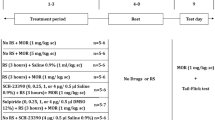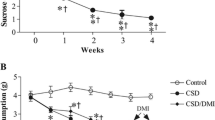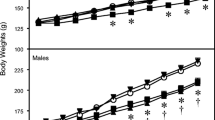Abstract
Chronic exposure to mild unpredictable stress has previously been found to depress the consumption of palatable sweet solutions. In the present study this effect was reversed by chronic (9 weeks) treatment with the atypical antidepressants, fluoxetine and maprotiline (5 mg/kg/day); the non-antidepressant chlordiazepoxide was ineffective. Stressed animals were also subsensitive to food reward in the place conditioning procedure; however, fluoxetine and maprotiline treated animals showed normal place preference conditioning. Acute pretreatment with raclopride (100 µg/kg) selectively reversed the recovery of sucrose drinking in antidepressant-treated stressed animals. These results extend previous reports of the efficacy of tricyclic antidepressants in this paradigm, and support the hypothesis of a dopaminergic mechanism of antidepressant action.
Similar content being viewed by others
References
American Psychiatric Association (1987) DSM IIIR- Diagnostic and statistical manual of psychiatric disorders, 3rd edn (revised). American Psychiatric Association, Washington DC
Anisman H Zacharko RM (1982) Depression: the predisposing influence of stress. Behav Brain Sci 5:89–137
Arnt J, Hytell J Overo KF (1984) Prolonged treatment with the specific 5-HT uptake inhibitor citalopram: effect on dopaminergic and serotonergic functions. Pol J Pharm Pharmacol 36:221–230
Asberg M, Eriksson B, Martensson B, Traskman-Bendz L, Wagner A (1986) Therapeutic effects of serotonin uptake inhibitors in depression. J Clin Psychiatry 47 Suppl 4:23–35
Bozarth MA (ed) (1987) Methods of assessing the reinforcing properties of abused drugs. Springer, Berlin Heidelberg New York
Bremner JD (1986) Fluoxetine in depressed patients: a comparison with imipramine. J Clin Psychiatry 45:414–419
Brown GW, Harris T (eds) (1988) Life events and illness. Guilford Press, New York
Carr GD, Fibiger HC, Phillips AG (1989) Conditioned place preference as a measure of drug reward. In: Liebman JM, Cooper SJ (eds) The neuropharmacological basis of reward. Oxford University Press, Oxford, pp 264–319
De Paulis T, Kumar Y, Johansson L, Ramsby L, Hall H, Sallemark M, Angeby-Moller K, Ogren S-O (1986) Potential neuroleptic agents 4: chemistry, behavioral pharmacology, and inhibition of (3H)-spiperone binding of 3,5-disubstituted N-((1-ethyl-2-pyrrolidinyl)methyl)-6-methoxy-salicylates. J Med Chem 29:61–69
Fawcett J, Clark DC, Scheftner WA, Gibbons RD (1983) Assessing anhedonia in psychiatric patients: the pleasure scale. Arch Gen Psychiatry 40:79–84
Kanner AD, Coyne JC, Schaefer C, Lazarus RS (1981) Comparison of two modes of stress measurement: Daily hassles and uplifts versus major life events. J Behav 4:1–39
Klein DF (1974) Endogenomorphic depression: a conceptual and terminological revision. Arch Gen Psychiatry 31:447–454
Klimek V, Maj J (1989) Repeated administration of antidepressant drugs enhanced agonist affinity for mesolimbic D-2 receptors. J Pharm Pharmacol 41:555–558
Klimek V, Nielsen M (1987) Chronic treatment with antidepressants decreases the number of [3H]SCH 23390 binding sites in the rat striatum and limbic system. Eur J Pharmacol 139:163–169
Lloyd C (1980) Life events and depressive disorders reviewed. 2. Events as precipitating factors. Arch Gen Psychiatry 37:541–548
Maitre L, Waldmeier PC, Greengrass PM, Jaeckel J, Sedlucek, S, Celina-Stula A (1975) Maprotiline—its position as an antidepressant in the light of recent neuropharmacological and neurobiochemical findings. J Int Med Res 3 [Suppl 2]:2–15
Maj J (1988) Repeated treatment with antidepressant drugs and functional changes of catecholajminergic receptors at the behavioural level. In: Belmaker RH, Sandler M, Dahlstrom A (eds) Progress in catecholamine research: part C, clinical aspects. Liss, New York, pp 255–261
Maj J, Wedzony K (1985) Repeated treatment with imipramine or amitriptyline increases the locomotor response of rats to (+)-amphetamine given into the nucleus accumbens. J Pharm Pharmacol 37:362–364
Maj J, Wedzony K (1988) The influence of oxaprotaline enantiomers given repeatedly on the behavioural effects ofd-amphetamine and dopamine injected into the nucleus accumbens. Eur J Pharmacol 145:97–103
Maj J, Rogoz Z, Skuza G, Sowinska H (1984a) Repeated treatment with antidepressant drugs potentiates the locomotor response to (+)-amphetamine. J Pharm Pharmacol 36:127–130
Maj J, Rogoz Z, Skuza G, Sowinska H (1984b) Repeated treatment with antidepressant drugs increases the behavioural response to apomorphine. J Neural Transm 60:273–282
Maj J, Wedzony K, Klimek V (1987) Desipramine given repeatedly enhances behavioural effects of dopamine andd-amphetamine injected into the nucleus accumbens. Eur J Pharmacol 140:179–185
Martin-Iverson M, Leclere JF, Fibiger HC (1983) Cholinergic-dopaminergic interactions and the mechanisms of action of antidepressants. Eur J Pharmacol 94:193–201
Montgomery SA (1980) Maprotiline, nomifensine, mianserin, zimelidine: a review of antidepressant efficacy in in-patients. Neuropharmacology 19:1185–1190
Moreau J-L, Jenck F, Martin JR, Mortas P, Haefely WE (1992) Antidepressant treatment prevents chronic unpredictable mild stress-induced anhedonia as assessed by ventral tegmental self-stimulation behavior in rats. Eur Neuropsychopharmacol 2:43–49.
Muscat R, Towell A, Willner P (1988) Changes in dopamine autoreceptor sensitivity in an animal model of depression. Psychopharmacology 94:545–550
Muscat R, Sampson D, Willner P (1990) Dopaminergic mechanism of imipramine action in an animal model of depression. Biol Psychiatry 28:223–230
Muscat R, Willner P (1992) Suppression of sucrose drinking by chronic mild stress: a methodological analysis, Neurosci Biobehav Rev (in press).
Nelson JC, Charney DS (1981) The symptoms of major depression. Am J Psychiatry 138:1–13
Papp M, Willner P, Muscat R (1991) An animal model of anhedonia. Attenuation of sucrose consumption and place preference conditioning by chronic unpredictable mild stress. Psychopharmacology 104:255–259
Papp M, Lappas S, Muscat R, Willner P (1992) Attenuation of place preference conditioning but not place aversion conditioning by chronic mild stress. J Psychopharmacol (in press)
Plaznik A, Kostowski W (1987) The effects of antidepressants and electroconvulsive shocks on the function of the mesolimbic dopamine system: a behavioural study. Eur J Pharmacol 135:389–396
Sampson D, Muscat R, Willner P (1991) Reversal of antidepressant action by dopamine antagonists in an animal model of depression. Psychopharmacology 104:491–495
Willner P, Montgomery A (1981) Behavioural changes during withdrawal from the tricyclic antidepressant desmethylimipramine (DMI). I. Interactions with amphetamine. Psychopharmacology 75:54–59
Willner P, Towell A, Sampson D, Muscat R, Sophokleous S (1987) Reduction of sucrose preference by chronic mild stress and its restoration by a tricyclic antidepressant. Psychopharmacology 93:358–364
Willner P, Sampson D, Papp M, Phillips G, Muscat R (1991) Animal models of anhedonia. In. Simon, P, Soubrie P, Widlocher D (eds) Animal models of psychiatric disorders, vol 3. Karger, Basel, pp 71–99
Winer BJ (1971) Statistical principles in experimental design. McGraw Hill, London
Zacharko RM, Anisman H (1991) Stressor-provoked alterations of intracranial self-stimulation in the mesocortiolimbic dopamine system: an animal model of depression. In: Willner P, Scheel-Kruger J (eds) The mesolimbic dopamine system, from motivation to action. Wiley, Chichester, pp 411–442
Author information
Authors and Affiliations
Rights and permissions
About this article
Cite this article
Muscat, R., Papp, M. & Willner, P. Reversal of stress-induced anhedonia by the atypical antidepressants, fluoxetine and maprotiline. Psychopharmacology 109, 433–438 (1992). https://doi.org/10.1007/BF02247719
Received:
Revised:
Issue Date:
DOI: https://doi.org/10.1007/BF02247719




